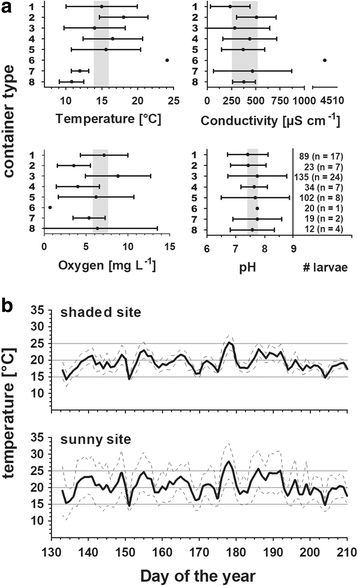Larval superiority of Culex pipiens to Aedes albopictus in a replacement series experiment: prospects for coexistence in Germany
- PMID: 29394910
- PMCID: PMC5797359
- DOI: 10.1186/s13071-018-2665-3
Larval superiority of Culex pipiens to Aedes albopictus in a replacement series experiment: prospects for coexistence in Germany
Abstract
Background: The Asian tiger mosquito Aedes albopictus is an extremely invasive, globally distributed and medically important vector of various human and veterinary pathogens. In Germany, where this species was recently introduced, its establishment may become modulated by interspecific competition from autochthonous mosquito species, especially Culex pipiens (s.l.). While competitive superiority of Ae. albopictus to Cx. pipiens (s.l.) has been described elsewhere, it has not been assessed in the epidemiological conditions of Germany. The present study aimed to determine if such superiority exists under the physicochemical and microclimatic conditions typical for container habitats in Germany.
Methods: In a replacement series experiment, the larval and pupal responses of Ae. albopictus and Cx. pipiens (s.l.) (mortality, development time, growth) to interspecific interaction (five larval ratios) at (sub-)optimal temperatures (15, 20 and 25 °C) and differing food supply (3 and 6 mg animal-based food larva-1) were investigated using a randomized split-plot design. In addition to physicochemical measurements of the test media, natural physicochemical conditions were determined for comparative analyses in mosquito breeding sites across the Rhine-Main metropolitan region of Germany.
Results: Under the physicochemical and microclimatic conditions similar to the breeding sites of the Rhine-Main region, competitive superiority of Cx. pipiens (s.l.) to Ae. albopictus in terms of larval survival was more frequently observed than balanced coexistence. Food regime and multifactorial interactions, but not temperature alone, were controlling factors for interspecific competition. Larval food regime and the larval ratio of Ae. albopictus influenced the physicochemistry and algal growth at 15 °C, with increased Ae. albopictus mortality linked to a decreasing number of Scenedesmus, Oocystis and Anabaena algae.
Conclusions: Under the present environmental conditions, the spread of Ae. albopictus from isolated foci in Germany may generally be slowed by biotic interactions with the ubiquitous Cx. pipiens (s.l.) (and potentially other container-breeding mosquito species) and by limnic microalgae in microhabitats with high resource levels. Detailed knowledge of the context dependency in temperate mosquito ecology, and interrelations of physicochemistry and phycology may help to achieve a better understanding of the upcoming Ae. albopictus colonization processes in central and northern Europe.
Keywords: Interspecific competition; Microalgae; Niche differentiation; Resource competition; Water chemistry.
Conflict of interest statement
Ethics approval and consent to participate
Not applicable.
Consent for publication
Not applicable.
Competing interests
The authors declare that they have no competing interests.
Publisher’s Note
Springer Nature remains neutral with regard to jurisdictional claims in published maps and institutional affiliations.
Figures





References
-
- European Centre for Disease Prevention and Control. Aedes albopictus. available from: http://ecdc.europa.eu/en/healthtopics/vectors/mosquitoes/Pages/aedes-alb.... Accessed 15 Apr 2016.
-
- Koch LK, Cunze S, Werblow A, Kochmann J, Dörge DD, Mehlhorn H, Klimpel S. Modeling the habitat suitability for the arbovirus vector Aedes albopictus (Diptera: Culicidae) in Germany. Parasitol Res. 2015;115(3):957-64. - PubMed
Publication types
MeSH terms
Substances
LinkOut - more resources
Full Text Sources
Other Literature Sources

